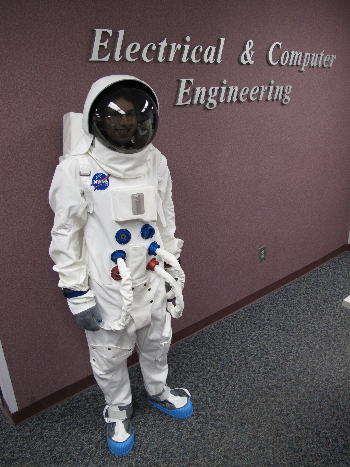NASA Missions
Welcome to NASA at Kansas State University !
NASA projects over the years have engaged K-State students in space-related research. This research has been directed at planetary-mission technology as well as human spaceflight.
Our most recent work focuses on developing a wireless biosensor network for health monitoring of astronauts. By studying the underlying principles of fatigue and researching signal propagation within a space-suit environment, we will create a commercial product that could be used in space walks by real astronauts. In addition to monitoring the muscle activity of an astronaut on an EVA, these same products could be used to monitor the progress of patients in rehabilitation clinics. Ultimately, the uses of such technology are endless, as new understandings of muscle failure are brought to light.
A large part of NASA's research efforts are focused on "Spinoff" technologies and future products that would improve the quality of life for all of humanity. Examples of these spinoffs include scratch-resistant lenses, memory foam, and even water filters. These innovations are spread throughout all fields and industries, and are fueled by research conducted by universities and companies all over the country.
Project Elements
This project is a cooperative effort amongst the Department of Kinesiology, the Department of Electrical and Computer Engineering (ECE) and the Electronic Design Laboratory at K-State, as well as various NASA centers and industry partners in Kansas. Within the three-year project we will develop and test intra-suit medical sensors, study and measure intra-suit wireless propagation, develop a wireless sensor communication network, develop and demonstrate radio hardware, and increase public awareness of NASA’s mission. Faculty and student efforts are divided among the following overlapping tasks:
Task 1: In the Department of Kinesiology students are using off-the-shelf sensors to determine what signal should be monitored. Once the desired signals are chosen, sensor development will progress. Three of our undergraduate students are currently reverse engineering commercial sensors.
Task 2: Students in the Electrical and Computer Engineering Department are working with two different electromagnetic models in EM Pro software, as well as having a mock suit made with conductive fabric to simulate the aluminized mylar layers in a space suit. Currently, we are using flexible ducts to do small-scale tests with an arm or leg.
Task 3: To structure the wireless network we first have to determine the data types, data rates and connectivity required. Some of these factors are dependent on the development of the sensors in task 1.
Task 4: The radio being developed is a modification of a micro-transceiver designed under a previous NASA project. Plans are in place to hand it off to a local Kansas company for mass production.
Task 5: This part of the project is dedicated to community outreach and encouraging diversity within STEM fields in universities across the nation. Over the summer the team provided workshops for three summer programs at K-State: Engineering and Science Summer Institute, EXCITE and GROW. We also purchased a replica space suit which is on display in the ECE office.

